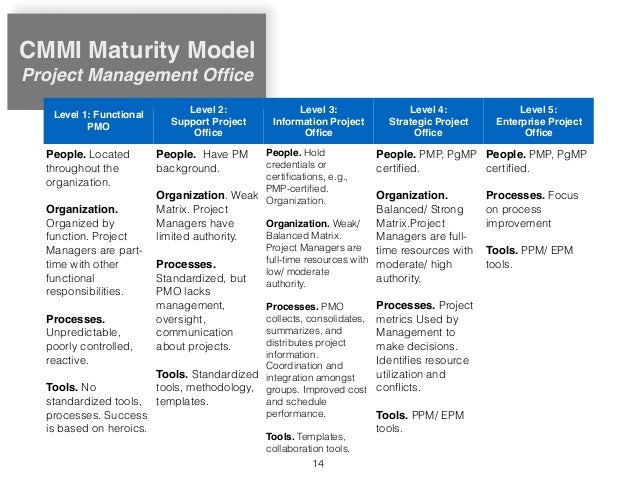- Pmo Maturity Model Ppt
- Cmmi Maturity Model Levels
- Cmmi Pmo Maturity Model
- Cmmi Maturity Model Pmo 2019
- Cmmi Maturity Model Pmo Definition
- Pmo Maturity Model Gartner


Summary
Capability Maturity Model Integration (CMMI) is a process improvement approach, which can be applied not only to projects, but also to departments or whole organizations. CMMI is used to access. A CMMI model may also be used as a framework for appraising the process maturity of the organization 6. CMMI Level VS PMO Level (adhoc Processes) Maturity Level 1 - Initial. At maturity level 1, processes are usually ad hoc and chaotic. The organization usually does not provide a stable environment. The CMMI-DEV, V1.3 model is a collection of development best practices from government and industry that is generated from the CMMI V1.3 Architecture and Framework.1 CMMI-DEV is based on the CMMI Model Foundation or CMF (i.e., model components common to all CMMI models and constellations2) and incorporates work by development organizations to. The Capability Maturity Model Integration (CMMI), as defined by CMMI institute, is “a capability improvement model that can be adapted to solve any performance issue at any level of the. The Capability Maturity Model Integration (CMMI) is a simple model to describe the evolution of the Project Management Office (PMO)’s roles. Figure 4 defines a series of evolution stages for a PMO in an organization. Each stage suggests a particular level of functional capability that the PMO will have achieved if functions are fully implemented.
At maturity level 4, the organization and projects establish quantitative objectives for quality and process performance and use them as criteria in managing projects.
Pmo Maturity Model Ppt
Description
Quantitative objectives are based on the needs of the customer, end users, organization, and process implementers. Quality and process performance is understood in statistical terms and is managed throughout the life of projects. For selected subprocesses, specific measures of process performance are collected and statistically analyzed. When selecting subprocesses for analyses, it is critical to understand the relationships between different subprocesses and their impact on achieving the objectives for quality and process performance. Such an approach helps to ensure that subprocess monitoring using statistical and other quantitative techniques is applied to where it has the most overall value to the business. Process performance baselines and models can be used to help set quality and process performance objectives that help achieve business objectives. A critical distinction between maturity levels 3 and 4 is the predictability of process performance. At maturity level 4, the performance of projects and selected subprocesses is controlled using statistical and other quantitative techniques, and predictions are based, in part, on a statistical analysis of fine-grained process data.
Contains
Cmmi Maturity Model Levels
- Organizational Process Performance (OPP) (CMMI-DEV)
- The purpose of Organizational Process Performance (OPP) (CMMI-DEV) is to establish and maintain a quantitative understan…
- Quantitative Project Management (QPM) (CMMI-DEV)
- The purpose of Quantitative Project Management (QPM) (CMMI-DEV) is to quantitatively manage the project to achieve the p…
Cmmi Pmo Maturity Model
Summary
At maturity level 4, the organization and projects establish quantitative objectives for quality and process performance and use them as criteria in managing projects.
Description
Cmmi Maturity Model Pmo 2019
Quantitative objectives are based on the needs of the customer, end users, organization, and process implementers. Quality and process performance is understood in statistical terms and is managed throughout the life of projects. For selected subprocesses, specific measures of process performance are collected and statistically analyzed. When selecting subprocesses for analyses, it is critical to understand the relationships between different subprocesses and their impact on achieving the objectives for quality and process performance. Such an approach helps to ensure that subprocess monitoring using statistical and other quantitative techniques is applied to where it has the most overall value to the business. Process performance baselines and models can be used to help set quality and process performance objectives that help achieve business objectives. A critical distinction between maturity levels 3 and 4 is the predictability of process performance. At maturity level 4, the performance of projects and selected subprocesses is controlled using statistical and other quantitative techniques, and predictions are based, in part, on a statistical analysis of fine-grained process data.
Cmmi Maturity Model Pmo Definition
Contains
Pmo Maturity Model Gartner
- Organizational Process Performance (OPP) (CMMI-DEV)
- The purpose of Organizational Process Performance (OPP) (CMMI-DEV) is to establish and maintain a quantitative understan…
- Quantitative Project Management (QPM) (CMMI-DEV)
- The purpose of Quantitative Project Management (QPM) (CMMI-DEV) is to quantitatively manage the project to achieve the p…